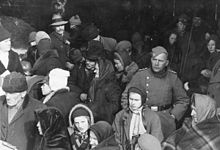Sahirne (Stryj)
| Cream brains | ||
| Загірне | ||

|
|
|
| Basic data | ||
|---|---|---|
| Oblast : | Lviv Oblast | |
| Rajon : | Stryi district | |
| Height : | 297 m | |
| Area : | 14.59 km² | |
| Residents : | 1,345 (2004) | |
| Population density : | 92 inhabitants per km² | |
| Postcodes : | 82466 | |
| Area code : | +380 3245 | |
| Geographic location : | 49 ° 16 ' N , 23 ° 59' E | |
| KOATUU : | 4625382701 | |
| Administrative structure : | 1 village | |
| Mayor : | Bohdan Hretschynskyj | |
| Address: | вул. Незалежності 3 82466 с. Загірне |
|
| Statistical information | ||
|
|
||
Sahirne (Ukrainian Загірне ; Russian Загорное / Sagornoje , German Gelsendorf ) is a village in Stryj Raion in Ukraine and is located about eight kilometers northeast of the district town of Stryj .
history
The model village of Gelsendorf was founded in 1784 as a purely German-Protestant place during the time of the Josephine colonization of Emperor Joseph II in eastern Galicia . Today the Ukrainian place is called Sahirne (literally translated: "Behind the height") and belongs to western Ukraine .
After the first partition of Poland in 1772, Eastern Galicia came to Austria and belonged to the Austrian Crown Land until the end of the First World War in 1919 and then to Poland until the resettlement in 1940.
The village is located on a fertile hill to the right of the Stryj River and before the resettlement had 36 farms and 20 cottagers (mostly artisans). In the middle of the village stood the Protestant church with rectory, the Protestant school and an inn.
Gelsendorf also included the Neu-Oleksice subsidiary , which was later founded by Gelsendorfern , located four kilometers south of Gelsendorf with nine house numbers (seven landlords and two house owners). Both places formed a political municipality with 350 German inhabitants, to which more than 100 Germans belonged, who lived in the Ukrainian neighboring villages of Alt-Oleksice (today Oleksytschi ), Jaroszyce (today Jaruschytschi / Ярушичі), Komarow (today Komariw / Комарів), Podhorce ( today Pidhirzi / Підгірці), Daszawa (today Daschawa / Дашава) and Juseptycze (today Jossypowystchi / Йосиповичі) lived. They were all German Gelsendorfer, belonged to the German Protestant parish Gelsendorf and also sent their children to the German Protestant Gelsendorf school. The Ukrainians from the neighboring towns helped the German farmers as day laborers with their farm work.
Until 1817 Gelsendorf was a branch municipality of Brigidau (today Laniwka ).
The first pastor in the then independent parish was Pastor Krajzel, followed by Pastors Lojka and Carl Gustav Zipser . Pastor Zipser was elected Superintendent of the Evangelical Superintendentur AB Galicia in 1886 . He held this high ecclesiastical office until his death on July 10th, 1896. Under his leadership a magnificent church was built in Gelsendorf. It was the most beautiful church in the German settlements in Galicia, it was destroyed towards the end of the war in 1944.
A German school was set up in Gelsendorf when the settlement was founded and was initially a walking school. The school was a one-class German-Protestant private school with public rights. Gelsendorf also had a post office, a village council, an elected mayor, a local group of the Federation of Christian Germans in Galicia and a German Raiffeisenkasse .
With the discovery and extraction of natural gas from 1921, Gelsendorf became one of the richest communities in Galicia. Ten natural gas shafts were built in the surrounding fields of the farmers in the 1920s and 1930s. All Gelsendorf citizens who had a household on the day the contract was signed with the natural gas companies were provided with gas pipes from the natural gas companies to the house free of charge, and natural gas for a stove, three ovens and light was supplied free of charge.
Gelsendorf made the impression of an aspiring, wealthy German community. Every visitor had a pleasant impression: wide, clean streets, well-preserved residential and farm buildings on both sides, embedded in dense orchards, the village surrounded by fertile, well-tended fields and meadows, hard-working, friendly people everywhere.
Gelsendorf held an outstanding position among the German villages in Galicia. In the first half of the 19th century, the German colonists were teachers of better land management, in the second half and until the relocation, they set the pace for a modern economy. Until the resettlement in 1940, the German tribal settlements had completely fulfilled their role model function in Eastern Galicia, embedded and surrounded by Ukrainian villages, in every respect - economically and culturally - according to the ideas of the great Austrian Emperor Josef II.
The history of the Germans in Eastern Galicia ended with the resettlement. After the land was taken over by the Soviet Union in 1945, the place was renamed Sagornoje / Sahirne and settled by Russian and Ukrainian farmers.
literature
Reichert, Oskar (ed.): "Gelsendorf, Galzien 1782 - 1940", self-published, Ratingen 2001
Web links
- Gelsendorf . In: Filip Sulimierski, Władysław Walewski (eds.): Słownik geograficzny Królestwa Polskiego i innych krajów słowiańskich . tape 2 : Derenek – Gżack . Sulimierskiego and Walewskiego, Warsaw 1881, p. 535 (Polish, edu.pl ).
- Impressions from the former Gelsendorf (Zahirne), Ukraine (PDF; 1.1 MB). Aid Committee of the Galiziendeutschen eV Publication from April 2016. Accessed on December 13, 2016.
- http://gelsendorf.jimdo.com/


